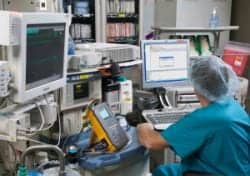While most CMMS providers offer nearly the same features and functionality, it’s up to the HTM shop to maximize their potential.
By Alan Gresch
Every year, 24×7 publishes a CMMS Roundtable, wherein representatives from various healthcare CMMS providers discuss important aspects and attributes of a CMMS for HTM. They are always well thought out and provide readers with valuable information regarding the things one should be looking for in a CMMS. There are also opportunities for each of the contributors to hold up the things that may differentiate their product from the others. They talk about integrations to cybersecurity platforms, RTLS solutions, ERP systems, and IoT devices. There is often discussion around the importance of mobility for easier use and increased productivity, a myriad of reporting and dashboarding capabilities, and the virtues of a cloud-based SaaS solution vs. an on-prem solution.
Certainly, all these features are important but they are something that any CMMS provider in this industry can provide. While the features and functionality of a CMMS will help you achieve the core requirements of regulatory compliance and likely include tools to enhance efficiency, will they drive significant change to your business to increase the value and recognition of your department within the organization you serve?
Many years ago, I created the HTM/HFM Maturity Curve to show the steps to take you from being a basic PM/break-fix department to one that is engaged in total lifecycle management of equipment. As you move up the curve, you will increase the value and recognition within your organization, along with your operational effectiveness.

Step 1 involves creating a clean and consistent data structure, along with a mechanism to keep your data clean and consistent. There’s an old adage that you can’t improve what you can’t measure. Without ensuring that all the devices in your database follow a standards-based nomenclature relative to the manufacturer, model, and device category, as well as a consistent and well-defined set of work order codes, it becomes difficult, if not impossible, to move any further up the curve.
This step also means ensuring that your staff documents everything they do so you can identify and reduce wasted time. The failure of almost all CMMSs comes from the failure to implement this first step. Garbage in, garbage out. Does your CMMS partner provide the ability to clean and normalize your data, equip you with a proven methodology to keep it clean, and offer mechanisms for ensuring accountability for complete and accurate documentation?
Step 2 is about centralizing and standardizing all your processes, policies, and procedures. Once you’ve reached the point where everything means the same thing, you ensure that everyone is doing the same thing. This step gives you all the information you need to benchmark internally and identify opportunities for improvement. Does your CMMS partner have the deep HTM or HFM experience, background knowledge, and software capability to help you centralize and standardize your workflows and processes and hold your staff accountable for following them?
When you have the data from completing Steps 1 and 2, Step 3 allows you to develop a set of meaningful KPIs. These are target metrics you track and report throughout the year, and they extend well beyond the information contained in a typical EOC Report. They will include things like cost savings and cost avoidance, cost of service ratio (overall, by department, by technician, and by modality), response times, turnaround times, uptime, and staff productivity.
I would even go so far as to say that you should publish these to your customers in the form of committed service level agreements (SLAs) so they know what to expect and that you are constantly working to improve your levels of service to them. Can your CMMS partner help you develop and track these metrics and show where you stand compared to the rest of the industry?
Step 4 is about intentionally raising your visibility and accountability within the organization. You are no longer hiding out in the basement. Instead, you are letting your clinical and administrative leadership know that you are going to do everything in your power to provide the best level of service at the lowest possible cost. This means you will take on anything relative to optimally managing your fleet of equipment throughout its lifecycle, including capital replacement planning (leveraging objective data from your CMMS) and getting the most out of your equipment at the end of its lifecycle through sale or redistribution. Taking this step will give organizational leaders the confidence that you are committed to minimizing cost and maximizing equipment availability.
Does your CMMS partner walk that journey with you? Do they understand what it will take to get you there and work with you to provide whatever integrations, interfaces, or reporting you will need to achieve that end? Do they consult with you to assess your current state operations and provide recommendations for cost savings, time savings, and overall process improvements?
Lastly, Step 5 is about driving your customer’s satisfaction to the highest level possible. The two most important metrics in our business are the cost-of-service ratio and customer satisfaction. If you direct every aspect of your business to nail those two, everything else takes care of itself. Does your CMMS partner have the background knowledge and expertise to help you devise a process workflow that keeps customers apprised of equipment status? Can they help you design and implement regular customer satisfaction surveys that will drive improvements in the service you deliver to your customers?
I keep referring to CMMS providers as “CMMS partners,” and that is what they should be. In my time working as a system director of clinical engineering in a large IDN and as vice president of capital equipment services in another, I would always strive to do business with people who were as invested in my success as I was. Yes, I had the drive and determination to make us the best we could possibly be, but the right partners made it a lot easier for us to achieve our end goal.
Alan Gresch is VP of HTM Consulting at Phoenix Data Systems.





